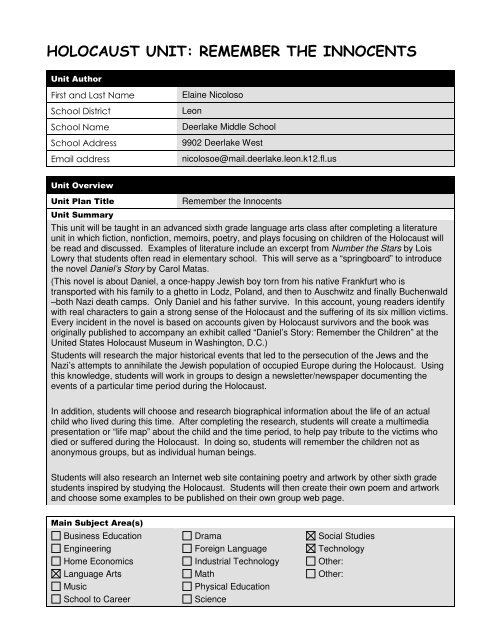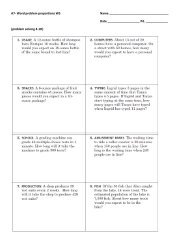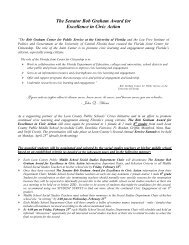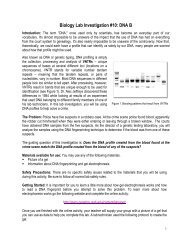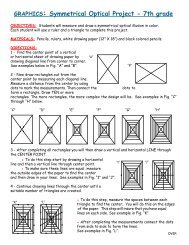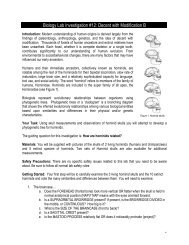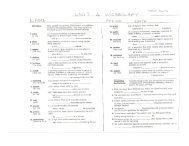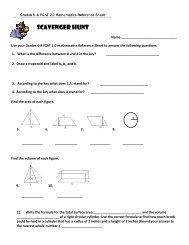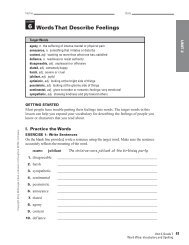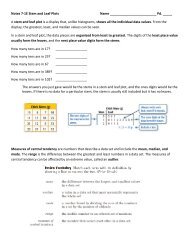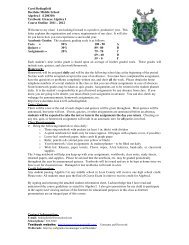holocaust unit plan - Deerlake Middle School
holocaust unit plan - Deerlake Middle School
holocaust unit plan - Deerlake Middle School
Create successful ePaper yourself
Turn your PDF publications into a flip-book with our unique Google optimized e-Paper software.
HOLOCAUST UNIT: REMEMBER THE INNOCENTS<br />
Unit Author<br />
First and Last Name<br />
<strong>School</strong> District<br />
<strong>School</strong> Name<br />
<strong>School</strong> Address<br />
Email address<br />
Elaine Nicoloso<br />
Leon<br />
<strong>Deerlake</strong> <strong>Middle</strong> <strong>School</strong><br />
9902 <strong>Deerlake</strong> West<br />
nicolosoe@mail.deerlake.leon.k12.fl.us<br />
Unit Overview<br />
Unit Plan Title<br />
Unit Summary<br />
Remember the Innocents<br />
This <strong>unit</strong> will be taught in an advanced sixth grade language arts class after completing a literature<br />
<strong>unit</strong> in which fiction, nonfiction, memoirs, poetry, and plays focusing on children of the Holocaust will<br />
be read and discussed. Examples of literature include an excerpt from Number the Stars by Lois<br />
Lowry that students often read in elementary school. This will serve as a “springboard” to introduce<br />
the novel Daniel’s Story by Carol Matas.<br />
(This novel is about Daniel, a once-happy Jewish boy torn from his native Frankfurt who is<br />
transported with his family to a ghetto in Lodz, Poland, and then to Auschwitz and finally Buchenwald<br />
–both Nazi death camps. Only Daniel and his father survive. In this account, young readers identify<br />
with real characters to gain a strong sense of the Holocaust and the suffering of its six million victims.<br />
Every incident in the novel is based on accounts given by Holocaust survivors and the book was<br />
originally published to accompany an exhibit called “Daniel’s Story: Remember the Children” at the<br />
United States Holocaust Museum in Washington, D.C.)<br />
Students will research the major historical events that led to the persecution of the Jews and the<br />
Nazi’s attempts to annihilate the Jewish population of occupied Europe during the Holocaust. Using<br />
this knowledge, students will work in groups to design a newsletter/newspaper documenting the<br />
events of a particular time period during the Holocaust.<br />
In addition, students will choose and research biographical information about the life of an actual<br />
child who lived during this time. After completing the research, students will create a multimedia<br />
presentation or “life map” about the child and the time period, to help pay tribute to the victims who<br />
died or suffered during the Holocaust. In doing so, students will remember the children not as<br />
anonymous groups, but as individual human beings.<br />
Students will also research an Internet web site containing poetry and artwork by other sixth grade<br />
students inspired by studying the Holocaust. Students will then create their own poem and artwork<br />
and choose some examples to be published on their own group web page.<br />
Main Subject Area(s)<br />
Business Education<br />
Engineering<br />
Home Economics<br />
Language Arts<br />
Music<br />
<strong>School</strong> to Career<br />
Drama<br />
Foreign Language<br />
Industrial Technology<br />
Math<br />
Physical Education<br />
Science<br />
Social Studies<br />
Technology<br />
Other:<br />
Other:
Grade Level<br />
K-2<br />
6-8<br />
ESL<br />
3-5 Gifted and Advanced<br />
9-12 Other:<br />
Resource<br />
Student Objectives/Learning Outcomes<br />
• Students will recognize that the Holocaust shook the foundations of modern civilization and<br />
that its unprecedented character and horror will always hold universal meaning.<br />
• Students will gain an increased awareness and understanding of the events of the Holocaust<br />
as an issue for humanity, based on a recognition that such events could happen again<br />
anywhere and at any time unless we ensure that our society is vigilant in opposing racism,<br />
anti-Semitism and other forms of bigotry.<br />
• Students will develop an understanding that prejudice, racism and stereotyping in a society<br />
has ramifications for themselves as individuals and as members of society.<br />
• Students will recognize the importance of understanding and combating the processes that<br />
led to the Holocaust.<br />
• Students will study the novel Daniel’s Story by Carol Matas as a class novel.<br />
• Students will choose, read, and discuss other fiction and nonfiction literature about the<br />
Holocaust.<br />
• Students will identify and apply universal themes found in literature to society.<br />
• Students will analyze historical information.<br />
• Students will locate, evaluate, summarize, and paraphrase information from a variety of print<br />
and electronic resources.<br />
• Students will demonstrate understanding with all those who suffered and still suffer because<br />
of the Holocaust, by creating and effectively presenting a researched, PowerPoint<br />
presentation or pictorial “life map” of a child as a tribute to the victims who died or suffered<br />
during the Holocaust.<br />
• Students will analyze poetry and artwork by other middle school students and create their<br />
own poem and artwork inspired by their study of the Holocaust.<br />
• Students will create a multimedia presentation, newsletter, or web page as a focus for<br />
educating other students about the Holocaust and the continued lessons that are learned<br />
from it.<br />
• Students will evaluate peer presentations adeptly, using rubrics.<br />
Student Multimedia/Publishing/Web Page Objectives<br />
• Students will learn and practice or master basic Word, Publisher, and PowerPoint skills.<br />
• Students will become aware of social, ethical, and human issues concerning copyright laws<br />
and source citations.<br />
• Students will use Word and PowerPoint (or Publisher) to communicate effectively.<br />
• Students will practice using research tools and techniques to locate and assimilate<br />
information found using the Internet, Microsoft Encarta Encyclopedia, and other electronic<br />
resources.<br />
• Students will learn to troubleshoot common software problems.<br />
• Students will evaluate the validity of information found on Internet sites.<br />
Targeted State Frameworks/Content Standards/Benchmarks<br />
FLORIDA SUNSHINE STATE STANDARDS
The <strong>unit</strong> will support the following Florida Curriculum Framework standards and benchmarks<br />
for grades 6-8 in Language Arts education.<br />
Reading<br />
LA.A 1.3.4 uses strategies to clarify meaning, such as rereading, note taking, summarizing,<br />
outlining, and writing a grade-level appropriate report.<br />
LA.A. 2.3.3 recognizes logical, ethical, and emotional appeals in the text.<br />
LA.A.2.3.5 locates, organizes, and interprets written information for a variety of purposes, including<br />
classroom research, collaborative decision making, and performing a school or real-world task.<br />
LA.A.2.3.6 uses a variety of reference materials, including indexes, magazines, newspapers, and<br />
journals, and tools, including card catalogs and computer catalogs to gather information for research<br />
topics.<br />
LA.A.2.3.7 synthesizes and separates collected information into useful components using a variety<br />
of techniques, such as source cards, note cards, spreadsheets and outlines.<br />
Writing<br />
LA.B.1.3.1 organizes information before writing according to the type and purpose of writing<br />
LA.B.1.3.2 drafts and revises writing uses appropriate and effective writing and applies wordprocessing<br />
or desktop-publishing capabilities, in drafting a report.<br />
LA.B.1.3.3 produces final documents that have been edited for: correct spelling, correct punctuation,<br />
correct capitalization, effective sentence structure, correct common usage, correct formatting, and<br />
with a varied sentence structure.<br />
LA.B.2.3.1 writes text, notes, outlines, comments, and observations that demonstrate<br />
comprehension of content and experiences from a variety of media.<br />
LA.B.2.3.2 uses information using alphabetical, chronological, and numerical systems.<br />
LA.B.2.3.4 uses electronic technology including databases and software to gather information and<br />
communicate new knowledge.<br />
Listening, Viewing, and Speaking<br />
LA.C.1.3.1 listens and uses information gained for a variety of purposes, such as gaining information<br />
from interviews, following directions, and pursuing a personal interest.<br />
LA.C.1.3.4 uses responsive listening skills, including paraphrasing, summarizing, and asking<br />
questions for elaboration and clarification.<br />
LA.C.2.3.1 determines main concept, supporting details, bias, and persuasion techniques in a<br />
nonprint message.<br />
LA.C.3.3.2 asks questions and makes comments and observations that reflect understanding and<br />
application of content, processes, and experiences.<br />
LA.C.3.3.3 speaks for various occasions, audiences, and purposes, including conversations,<br />
discussions, projects, and informational, persuasive, or technical presentations.<br />
Language<br />
LA.D.1.3.2 demonstrates an awareness that language and literature are primary means by which<br />
culture is transmitted.<br />
LA.D. 2.3.4 understands how the multiple media tools of graphics, pictures, color, motion, and music<br />
can enhance communication in television, film, radio, and advertising.<br />
LA.D. 2.3.5 incorporates audiovisual aids in presentations.<br />
LA.D. 2.3.7 understands that laws exist that govern what can and cannot be done with mass media.
Literature<br />
LA.E.1.3.1 identifies the defining characteristics of classic literature, such as timelessness, deals<br />
with universal themes and experiences, and communicates across cultures.<br />
LA.E.2.3.2 responds to a work of literature by interpreting selected phrases, sentences, or passages<br />
and applying the information to personal life.<br />
LA.E. 2.3.3 knows that a literary text may elicit a wide variety of valid responses.<br />
LA.E. 2.3.4 knows ways in which literature reflects the diverse voices of people from various<br />
backgrounds.<br />
LA.E.2.3.5 recognizes different approaches that can be applied to the study of literature, including<br />
thematic approaches such as change, personal approaches such as what an individual brings to his<br />
or her study of literature, and historical approaches such as how a piece of literature reflects the time<br />
period in which it is written.<br />
Procedures<br />
Number the Stars “springboard “ activities<br />
The excerpt from Number the Stars is to be used as a “springboard” to begin a more in depth <strong>unit</strong><br />
study of the Holocaust. The excerpt is a good example to initiate discussion about how children’s<br />
lives (especially Jewish children’s lives) were affected by the Nazis.<br />
1. Pre-reading activity: Ask class to look at each other. Do they look alike What makes<br />
them different Do they think everyone should look the same Writing journal topic: How<br />
would you respond if you were banned from a shop or a park because of where you were<br />
from, the way you look or the way you dress What would you try to do to make sure that you<br />
were treated equally<br />
2. Inform students that they will begin a <strong>unit</strong> dealing with the Holocaust when certain groups of<br />
people were not treated equally. Students brainstorm with classmates to fill in a K-W-L<br />
chart on the Holocaust. (Some students will have read Holocaust literature in elementary<br />
school and will have some knowledge.)<br />
3. In small groups, students work together to write definitions for the following vocabulary terms<br />
used in the story: occupation, exasperated, rationed, belligerently, unwavering, disdainfully,<br />
frustration, resistance. The groups should also write their own sentences to show that they<br />
understand the meaning of the word.<br />
4. Inform students that they will be reading an excerpt from Number the Stars by Lois Lowry—a<br />
novel that tells the story of two young girls resisting the Nazi <strong>plan</strong> to “relocate” Denmark’s<br />
Jews. The excerpt introduces the beginning of Nazi oppression in Denmark with the closing<br />
of Jewish businesses (Mrs. Hirsch’s button shop) and culminates in a frightening middle of the<br />
night visit by Nazis to the Johansen home where Annemarie’s Jewish friend, Ellen, is hiding.<br />
The quick thinking of Mr. Johansen and Annemarie convince the Nazis that Ellen is a member<br />
of their family thereby preventing Ellen’s capture.<br />
5. After reading the excerpt aloud in class and pausing for discussion and to clarify<br />
understanding, students will discuss the excerpt using questions from the “Question<br />
Matrix”. For example:<br />
What were some of the wartime shortages faced by the characters<br />
How were the children in the story affected by what was happening at this time How do you<br />
think you would have coped<br />
Why did Annemarie yank the Star of David necklace from Ellen’s neck<br />
What would have happened if Mr. Johansen had not had a baby photo of Lise (his dead<br />
daughter) that showed she had dark hair<br />
What would you have done if you were either Mrs. Johansen, Mr. Johansen, Ellen or
Annemarie when the Nazis burst into your apartment<br />
How would you have felt if you were Ellen in this situation<br />
What do you think will happen next (For students who have read the whole book, ask them<br />
to refrain from answering this now.)<br />
How do you think will Ellen get to safety<br />
How will Ellen have to change her activities and lifestyle now that she is pretending to be<br />
Annemarie’s sister<br />
What do you think would have happened if Kirsti, Annemarie’s younger sister, had woken up<br />
during the raid<br />
6. Students complete the “What a Night” activity sheet for which they have to imagine that<br />
they have joined the Johansens and Ellen Rosen at the breakfast table the next morning<br />
when they are discussing Ellen’s narrow escape. Students are asked to complete a<br />
dialogue for what they, as well as the characters, would say.<br />
7. In small groups, students use the six stages of the creative problem solving process to<br />
discuss and come up with solutions to try to help Ellen survive and escape capture by the<br />
Nazis. (For students who may have read the book, and know how the novel ends, they will<br />
work together as a group(s) to determine an alternative method to get Ellen to safety.)<br />
8. Students may also complete a story/study guide for the excerpt for a quiz on the story.<br />
9. At this point, call on the “experts”—those students who might have read the whole book—to<br />
give a summary of what actually happens to Ellen and her family.<br />
10. In addition, the teacher may wish to give additional historical information about the Danish<br />
people, a very small minority of people under Nazi occupation, who bravely decided to help<br />
the Danish Jews escape the proposed “relocation” by the Nazis in 1943. Point out that<br />
although Number the Stars is fiction, it was drawn from true accounts of the Danish<br />
Resistance, which succeeded in saving the lives of almost all of Denmark's nearly 8,000<br />
Jews. (Denmark was the only occupied country in World War II to save almost all its Jews<br />
from extermination, by smuggling them out of the country.) Ask students to consider WHY<br />
they think Denmark was the only country to do this. Interested students could do<br />
further research about Danish resistance to the Nazis.<br />
11. Inform students that they will be learning more about the Holocaust and particularly how it<br />
affected children. They should also choose and read independently an appropriate novel or<br />
biography about the Holocaust concurrently with the Remember the Innocents <strong>unit</strong>. Allow<br />
time for students to visit the media center or classroom library to select books. After<br />
completion of the book, students should complete either a “Fiction Book Report” form or a<br />
“Biography/Autobiography Book Report “ form. (See Unit Support materials.)<br />
PRE-READING DISCUSSION ACTIVITIES AND BACKGROUND INFORMATION<br />
12. Have you read other books about the Holocaust set in Europe during World War II When<br />
and where were these stories set What did you learn about life at that time<br />
What does the word “prejudice” mean to you What causes it How can it be prevented or<br />
overcome<br />
Background information:<br />
13. Before beginning the novel, students will receive a map of Europe for the late 1930’s and will<br />
be asked to trace the action of the story. Students will also read and discuss background<br />
historical information about the Holocaust. Because many middle school students find it difficult<br />
to comprehend why and how the Holocaust began, students will be asked to consider the<br />
economic, sociological, and other factors in post World War I Germany that influenced the<br />
majority of German people to accept the ideology of Hitler and the Nazi party. Other areas of
discussion from the background material will include:<br />
The rise of the Nazi party.<br />
The road to World War II<br />
Why study the Holocaust<br />
The Holocaust in history (Other examples of persecution of the Jewish people)<br />
The unique tragedy of the Holocaust (What makes the Holocaust different from other acts of<br />
genocide)<br />
The scope of the Holocaust (ghettos, slave labor camps, concentration camps, death camps,<br />
number of people murdered during the Holocaust, number of Jews in Europe who survived<br />
etc.)<br />
14. Students will be given a list of vocabulary words for each of the four sections of the book, as<br />
some of the words may not be familiar to them. Students will also receive a study guide for each<br />
section.<br />
15. To assist in understanding the background information about what was happening in<br />
Germany, students will watch an excerpt from the DVD version of Into the Arms of<br />
Strangers (an Academy Award Winner for best documentary feature in 2000). The<br />
documentary is about the 10,000 children saved from the Nazi regime when the British<br />
government implemented a <strong>plan</strong> called “Kindertransport”, which allowed many children to<br />
leave the horrors of the Nazi regime and find temporary refuge within British families and<br />
hostels. The excerpt shows what it was like to be a Jewish child growing up in the<br />
shadow of the Nazi threat and how the children’s safe, familiar world was quickly<br />
changed. The excerpt includes first-hand testimonies of some of the people who were<br />
children at this time.<br />
16. Writing journal activities for the excerpt from Into the Arms of Strangers:<br />
(Choose one)<br />
Write about a time when you departed from a place that was important to you. What and who<br />
made it difficult to leave<br />
Consider the lessons or values your parents, guardians, or friends have taught you<br />
throughout your life. What qualities in those people do you appreciate or take for granted<br />
How have they prepared you to face the world How might you offer a tribute to one of these<br />
individuals<br />
Using the stories you have heard in the film, reflect on the meaning of “home”. What parts of<br />
home can and cannot be taken with you In a poem, a story, or another medium of creative<br />
expression, write about the ways in which refugees in the past, as well as today, have<br />
attempted to create home in a new place.<br />
Imagine that you are one of the children selected to leave Nazi Germany and your parents<br />
and travel to a different country where you will not understand the language. How might you<br />
feel Either write a journal/diary entry you might make during your last week, or write a<br />
farewell letter to your parents.<br />
Note for Curriculum Compacting: If there are students who have already read the book<br />
Daniel’s Story, those students may have the option of reading another book about children of the<br />
Holocaust and creating a presentation for the class. Some titles include:<br />
NONFICTION<br />
Into the Arms of Strangers: Stories of the Kindertransport by J. Harris & D. Oppenheimer(Based<br />
on the documentary)<br />
The Holocaust Personal Accounts by D. Scrase & W. Mieder
Reflections of a Childhood Friend: Memories of Anne Frank by Alison L. Gold<br />
A Place to Hide edited by Jayne Pettit<br />
Surviving Hitler: A Boy in the Nazi Death Camps by Andrea Warren<br />
The Hidden Children by Howard Greenfeld<br />
The Hidden Children: The Secret Survivors of the Holocaust by Jane Marks<br />
Hide and Seek by Ida Vos<br />
Hiding to Survive by Maxine Rosenberg<br />
Hiding from the Nazis by David A. Adler<br />
Ten Thousand Children: True Stories Told by Children Who escaped the Holocaust on the<br />
Kindertransport by Anne Fox & Eva Abraham-Podietz<br />
Four Perfect Pebbles: A Holocaust Story by Lila Perl & Marion Blumenthal Lazan<br />
Joseph and Me: In the Days of the Holocaust by Judy Hoffman<br />
Escape or Die: True Stories of Young People Who Survived the Holocaust. By Ina Friedman<br />
Clara’s Story by Clara Isaacman<br />
Your Name Is Renee: Ruth Hartz’s Story As a Hidden Child in Nazi-Occupied France. Stacy<br />
Cretzmeyer<br />
Alicia’s Story by Alicia Appleman-Jurman<br />
We Are Witnesses: The Diaries of Five Teenagers Who Died in the Holocaust by Jacob Boas<br />
I Have Lived a Thousand Years by Livia Bitton-Jackson<br />
All but My Life by Gerda Weissmann Klein<br />
Children in the Holocaust and World War II by Laurel Holliday<br />
Hannah Szenes: A Song of Light by Maxine Rose Schur<br />
Behind the Secret Window by Nelly S. Toll<br />
Dry Tears by Nechama Tec<br />
The Cage by Ruth Minsky Sender<br />
The Diary of Dawid Sierakowiak edited by Alan Adelson<br />
Mischling, Second Degree by Ilse Koen<br />
FICTION<br />
Anna Is Still Here by Ida Vos<br />
Friedrich by Hans Peter Richter<br />
A Traitor Among Us by Elizabeth Van Steenwyk<br />
Upon the Head of a Goat: A Childhood in Hungary 1939-1944 by Aranka Siegal<br />
The Devil in Vienna by Doris Orgel<br />
The Upstairs Room by Johanna de Leeuw Reiss<br />
Shadow of the Wall by Christa Laird
DANIEL’S STORY by Carol Matas<br />
Students will read most of this novel in class. The teacher will read aloud as well as other<br />
students. Some parts will be read silently. Students have a study guide for each section of the<br />
book.<br />
In addition to discussing questions on the study guide for each section of the novel, the<br />
following questions may be used for class and/or small group discussion:<br />
17. CHAPTERS 1-4<br />
Why does Daniel look at his photographs on the train<br />
What probably led to the argument between Uncle Walter and Father at Daniel’s sixth birthday<br />
party<br />
Contrast Daniel’s feelings about going to the Jewish school with that of his mother. What do you<br />
think accounted for the difference<br />
Why do you think Mr. Schneider, Daniel’s teacher, felt it was possible to aim anti-Semitic remarks<br />
at Daniel Describe how you would feel if you were Daniel in this situation.<br />
Why do you think so many Jews remained in Germany after the Nazis rose to power and so<br />
many Jews emigrated<br />
Why do you think that many countries would not accept Jews who were trying to escape Nazi<br />
persecution Explain why you think the same thing could or could not happen today.<br />
Writing journal activities: (Choose one)<br />
Daniel has a special relationship with Uncle Peter. Describe the special relationship you have<br />
with a relative or other adult.<br />
Write about a time when you or someone you know was faced with unfair treatment. Describe<br />
the incident and how you felt.<br />
Imagine that you are a reporter for a German newspaper who was on the scene in Frankfurt,<br />
Germany, on Kristallnacht. Write an editorial describing what you saw and how you felt about<br />
what was happening. Then imagine that you are a reporter for a Jewish newspaper. Write an<br />
editorial from that viewpoint. (How will the two be different)<br />
18. CHAPTERS 5-9<br />
Why did Auntie Leah decide that Erika and Friedrich should hide in the cupboard and not her<br />
youngest children What does this suggest about her<br />
What uncharacteristic behavior did Erika exhibit at a resistance meeting What does this suggest<br />
about her<br />
Do you think Auntie Leah and Daniel’s family made the right decision about Leah’s children Did<br />
they have any other available options (In small groups, students can use the Six Thinking<br />
Hats technique OR the six stages of the Critical Thinking technique to brainstorm possible<br />
alternatives.)<br />
What is as important to you as Erika’s music was to her Why How would you feel if it were<br />
taken away from you<br />
Why do you think that some individuals survived Nazi persecution, while others did not Were<br />
character traits or chance more significant Explain.<br />
Writing journal activities: (Choose one)<br />
We know how Daniel feels about Rosa, but we are not certain how Rosa feels. Imagine that you<br />
are Rosa. Write a journal entry in which you tell about your feelings for Daniel.
Use a Venn diagram to compare and contrast the characters of Rosa and Erika. Using the<br />
information from the Venn diagram, write a character sketch of either Rosa or Erika.<br />
19. CHAPTERS 10-12<br />
Why did the resistance movement at Auschwitz think Daniel might be useful to them Why did<br />
Daniel’s father encourage him to risk doing this<br />
How did Father’s practical skills help Daniel survive in Auschwitz<br />
Do you think the experiences of living through the Holocaust would strengthen or weaken a<br />
person’s religious beliefs Explain.<br />
Why do you think the German civilians at the railroad platform showed no emotion as the<br />
wretched prisoners from Auschwitz were loaded on the train<br />
Why do you think the Allies did not use the smuggled information about Auschwitz to bomb the<br />
railroad lines thereby halting or slowing the transportation of Jews to their death (In small<br />
groups, students can use the Six Thinking Hats technique OR the six stages of the Critical<br />
Thinking technique to brainstorm.)<br />
Writing journal activity:<br />
The “fiery image” of the day Daniel looked into the pit stayed burned in his mind. Describe a<br />
particular image, happy or sad, that you will never forget from your life and tell why it is important.<br />
20. CHAPTERS 13-16<br />
Contrast the lives of the Nazis at Buchenwald with those of the prisoners.<br />
How did the conditions at Buchenwald compare with those at Auschwitz<br />
What realization came to Daniel after the incident with Peter at the train station in Poland<br />
Do you think that civilians could have done anything to stop the Holocaust<br />
How do you think people who survived the concentration camps were able to rebuild their lives<br />
How could they live with their memories<br />
Peter’s last word was “Remember”. What do you think he meant<br />
Writing journal activities: (Choose one)<br />
Imagine that you are one of the first Americans to enter Buchenwald. In a letter, describe what<br />
you saw and your feelings at the time.<br />
In well-developed paragraphs, tell describe how this book has affected you. Would you<br />
recommend it to others Why, or why not<br />
Create a short sequel to the book in which you continue the story of Rosa and Daniel’s life.<br />
21. POST-READING ACTIVITES AND DISCUSSION QUESTIONS<br />
Discussion questions:<br />
1. Why do you think Daniel and his father were able to survive while others perished How were<br />
they and other members of their family able to maintain their dignity in the face of overwhelming<br />
brutality<br />
2. George Santayana wrote, "those who cannot remember the past are condemned to repeat it.” Do<br />
you agree with this statement Why, or why not In what way does this statement relate to the<br />
novel (From George Santayana, The Life of Reason. Simon & Schuster.)<br />
3. Do you think this novel would make a good motion picture Why or why not Whom would you
cast in the major roles Would you leave out any parts of the book or add any background material<br />
4. 4. Return to the K-W-L chart that you began on page five of this study guide. Add any information<br />
about the Holocaust you learned while reading the book. Correct any misconceptions you might<br />
have expressed in column one.<br />
Cooperative Learning Activities:<br />
5. Discuss these questions with your group: What are some of the lessons that can be learned from<br />
the Holocaust Why is it important that we know about these atrocities How can we prevent<br />
something like this from happening again<br />
6. Do you think that the author was justified in describing so many disturbing aspects of<br />
concentration camp life Debate the issue with classmates who hold a different point of view.<br />
7. Anti-Semitism and other forms of prejudice are constant issues. Discuss current news items<br />
describing incidents of prejudice. With your group members, discuss ways these prejudices might be<br />
overcome.<br />
8. Radio played an important part in ghetto life. With your group members, <strong>plan</strong> and present a radio<br />
news broadcast that Daniel might have heard. Have a few members of your group write a script for<br />
the broadcast which should focus on an important event of Daniel's time: the D-day invasion, the<br />
attempted coup against Hitler, or any other historical event mentioned in the novel.<br />
9. Do some research on the founding of the state of Israel to learn about the difficult future people<br />
such as Daniel and Rosa faced if they emigrated to Palestine in 1945. Present this information to the<br />
class.<br />
10. Research and complete the “Science Connections” activity sheet<br />
CULMINATING INDIVIDUAL AND GROUP PROJECT FOR REMEMBER THE INNOCENTS<br />
After researching, students will create:<br />
Individual components:<br />
i. A Holocaust Identity Card for the child they researched and modeled on those issued to visitors<br />
at the National Holocaust Memorial Museum.<br />
ii. Either a PowerPoint presentation OR “Life map” of the child they chose to research.<br />
iii.<br />
A poem OR artwork representing their thoughts about the Holocaust.<br />
Group components:<br />
iv. An edition of the Holocaust Chronicle, a newspaper/newsletter that focuses on the events<br />
leading up to and including the Holocaust.<br />
OR<br />
v. A webpage containing various information about the Holocaust. (See info below.)<br />
PROCEDURES:<br />
22. Before beginning this part of the <strong>unit</strong>, the teacher should make a folder on the desktop of<br />
each of the computers that will be used containing the main Web sites for the <strong>unit</strong>. This will allow<br />
students to easily access appropriate Holocaust sites, and avoid the potential problem of students<br />
randomly searching for sites and possibly accessing inappropriate sites that might contain images<br />
that could be upsetting. To create the folder, save the addresses of favorites in a file on a disk,<br />
and then transfer that file to each computer.<br />
23. Explain to the students that they will choose and research an individual child who lived during<br />
the Holocaust and then design and create a PowerPoint presentation or pictorial “life map” about<br />
the child’s life as a memorial or tribute to that child. Students will also create a Holocaust “Identity<br />
Card” for the child they chose.<br />
24. Give students a copy of “Children of the Holocaust” list. Students should choose a child from
the list to research. Students in the same class should not choose siblings from the list, as<br />
the biographical information on siblings is very similar.<br />
25. In the computer lab, give each student his or her labeled computer disk. (Purchased for them<br />
from the money they brought in ahead of time.) Show students how to create folders on their<br />
disk to store files. Each student should create an “Images and Sounds” folder, a<br />
“PowerPoint” folder, a “Web Page” folder, a “Newsletter” folder, a “Works Cited” folder and a<br />
“Research” folder.<br />
26. Give students a copy of the student handout “Children of the Holocaust Internet Research”.<br />
Using the directions on the handout, students use the computers to research information<br />
about the child that they selected at the Simon Wiesenthal Museum of Tolerance Web site or<br />
at http://www.graceproducts.com/fmnc/main.htm<br />
27. After locating the biographical information about the child, students should print a copy of the<br />
information and save the information as a text file in their “Research” folder on their computer<br />
disks. The photograph of the child should also be saved as an image in the “Images and<br />
Sounds” folder.<br />
28. After completing steps 6 and 7, students should read over their research information and<br />
complete the sections on the “Remember the Innocents Research Sheet” handout.<br />
(Depending on which child they chose and the biographical information about that child, some<br />
students may not be able to complete all sections of the handout.)<br />
29. Explain the requirements for the PowerPoint presentation to the students. Show the<br />
Remember the Innocents PowerPoint student example to give students a model for their<br />
presentation.<br />
30. Using the “PowerPoint Planning Sheet” students will <strong>plan</strong> their PowerPoint presentation,<br />
deciding what written information and graphics they will include as an appropriate way to<br />
memorialize the child that they researched.<br />
31. After completing and editing the <strong>plan</strong>ning sheet, students will need time on the computers to<br />
research appropriate illustrations, maps, archival photographs etc., to include in their<br />
presentation or for their “life map”. Students should save all images on their computer disk in<br />
the “images and sounds” folder.<br />
32. Using MS Power Point, students will complete their memorial tribute to a child of the<br />
Holocaust. After completing the text and graphics, students should check for correct spelling,<br />
usage, and grammar. Students will then need computer time to enhance their presentation<br />
with custom animation or sounds, etc. All work should be saved in the “PowerPoint Folder”<br />
on the student’s disk.<br />
33. Students will showcase their presentation or “life map” to the class, and possibly again later<br />
for parents.<br />
34. Presentation will be graded using the “Power Point Scoring Rubric.”<br />
35. In small groups, each group will research the Holocaust time period that they were assigned<br />
and write articles for an edition of the Holocaust Chronicle, a newspaper/newsletter that<br />
focuses on the events leading up to and including the Holocaust. Suggested time periods<br />
could include: Germany 1933-35, Germany 1935-38, 1939-41, 1942-43, 1944-45. However,<br />
the time periods could be broken into smaller <strong>unit</strong>s, or into time periods of Nazi occupation of<br />
particular countries such as Poland, Hungary, France and the Netherlands, if more groups<br />
were needed, or for assisting resource students. Students can view the sample Holocaust<br />
Chronicle as a printed version and/or as a Publisher file using a projection system.<br />
36. Students use the “Newsletter/Newspaper Planning Sheet” to <strong>plan</strong> the articles and graphics for<br />
their newspaper. Students will need computer time to complete the newsletter project. The<br />
work should be saved in the “Newsletter Folder”.<br />
37. After each group completes their edition of the Holocaust Chronicle, it can be scored using
the “Newsletter Scoring Rubric”. The editions produced by the groups could be compiled into<br />
one newspaper if desired.<br />
38. Students should research the Imagine Art Gallery Website at<br />
http://www.remember.org/imagine/imagine1.html to view examples of art and poetry about<br />
the Holocaust by other middle school students. Each student will then create their own poem<br />
or artwork inspired by their studies and research about the Holocaust. These assignments<br />
will be graded as language arts grades.<br />
39. In small groups, students should select biographical information about one child of the<br />
Holocaust to include in a Web page. The child they select can be one that a group member<br />
has already researched, or a different child from the list given at the Web site<br />
http://www.graceproducts.com/fmnc/main.htm<br />
40. The group will also select some of the poems and artwork created by the members of the<br />
group to include in the Web page. The drawings will need to be scanned. Students will also<br />
include a page of useful links, as well as any other information that they think will help pay<br />
tribute to child victims of the Holocaust.<br />
41. Students should examine the student Web page sample for Remember the Innocents so that<br />
they will have a model to help them <strong>plan</strong>.<br />
42. The students will use the “Web Page Planning Sheet” to help <strong>plan</strong> the pages of their Web<br />
page. Students will need computer time to complete the Web page using MS Publisher.<br />
Approximate Time Needed<br />
Including the prior literature <strong>unit</strong> about the Holocaust, this <strong>unit</strong> should take approximately 6 weeks.<br />
Prerequisite Skills<br />
Familiarity with MS Publisher, MS PowerPoint, Ms Word, Internet Explorer, or Netscape.<br />
Materials and Resources Required For Unit<br />
Technology – Hardware<br />
Camera<br />
Computer(s)<br />
Digital Camera<br />
DVD Player<br />
Internet Connection<br />
Laser Disk<br />
Printer<br />
Projection System<br />
Scanner<br />
Television<br />
VCR<br />
Video Camera<br />
Video Conferencing Equip.<br />
Other:<br />
Technology – Software<br />
Database/Spreadsheet<br />
Desktop Publishing<br />
E-mail Software<br />
Encyclopedia on CD-ROM<br />
Image Processing<br />
Internet Web Browser<br />
Multimedia<br />
Web Page Development<br />
Word Processing<br />
Other:
Printed Materials<br />
Study guides and vocabulary lists for excerpt from Number the Stars<br />
and Daniel’s Story.<br />
List of names for “Children of the Holocaust”.<br />
“Children of the Holocaust Internet Research” sheet.<br />
“Remember the Innocents Research Sheet”<br />
Book report forms for fiction and biography/autobiography.<br />
Planning sheets for PowerPoint, newsletter and Web page.<br />
Rubric scoring guides for multimedia presentation, newsletter, and<br />
Web page.<br />
Supplies<br />
Drawing paper, pencils, colored pencils, markers or paint, glue<br />
Computer disk for each student.
Children of the Holocaust Web site. (Main site for researching<br />
biographical information about children of the Holocaust.)<br />
http://www.wiesenthal.com/mot/children/list1.cfm<br />
Imagine Art Gallery (Artwork and poems by middle school students<br />
studying the Holocaust.)<br />
http://www.remember.org/imagine/imagine1.html<br />
Museum of Tolerance. (Comprehensive resource dealing with the<br />
Holocaust.) http://www.moltc.wiesenthal.com/<br />
The Holocaust History Project (A free archive of documents,<br />
recordings, photographs and essays.)<br />
http://www.<strong>holocaust</strong>-history.org/<br />
United States Holocaust Memorial Museum (Comprehensive<br />
resource for teachers and students, which includes a Holocaust<br />
timeline.) http://www.ushmm.org/<br />
Survivors of the Shoah. (Visual History Foundation established by<br />
Steven Spielberg to chronicle first-hand accounts of the Holocaust<br />
before it is too late.)<br />
http://www.vhf.org/<br />
Holocaust Memorial Center (Archive of documents, photographs,<br />
recordings and essays about the Holocaust, and includes a timeline)<br />
http://www.<strong>holocaust</strong>center.org/<br />
Teaching the Holocaust with the Internet (Very comprehensive list<br />
of over 100 links to Holocaust related sites.)<br />
http://twi.classroom.com/<strong>holocaust</strong>/<br />
Internet Resources<br />
Simon Wiesenthal Center Multimedia Learning Center Online<br />
(Teacher Resource Guide for teaching the Holocaust)<br />
http://motlc.wiesenthal.com/resources/courage/curriculum.html<br />
A Teacher’s Guide to the Holocaust (Comprehensive source of<br />
articles, photographs, activities etc. produced by the Florida Center<br />
for Instructional Technology at the University of South Florida. Also<br />
includes a detailed timeline.)<br />
http://fcit.usf.edu/<strong>holocaust</strong>/sitemap/sitemap.htm<br />
Holocaust Software List of Software titles on the Teacher’s Guide to<br />
the Holocaust Web site.<br />
Boston Public Library’s Annotated Bibliography of young adult<br />
books about the Holocaust.<br />
http://www.bpl.org/teens/booklists/<strong>holocaust</strong>.htm<br />
<strong>Middle</strong> <strong>School</strong> Holocaust Bibliography (Annotated Bibliography)<br />
http//fcit.coedu.usf.edu/<strong>holocaust</strong>/resource/books.htm<br />
Holocaust Bibliography<br />
http://www.scetv.org/HolocaustForum/hobib0.html<br />
Education. . . A Legacy Forum for Teaching the Holocaust<br />
Annotated Holocaust Bibliography<br />
http://www.remember.org/educate/anbib2.html
Others<br />
Access to library and computer lab.<br />
Novels and nonfiction books about the Holocaust.<br />
Accommodations for Differentiated Instruction<br />
Gifted Student<br />
Student Assessment<br />
Key Word Search<br />
1. Students help bookmark appropriate web sites.<br />
2. Students can act as technology assistants as well as completing<br />
their own projects.<br />
3. Students may be challenged to create a more technically<br />
advanced PowerPoint presentation, newsletter, or web site.<br />
4. Students may act as tutors and leaders for students in other<br />
classes<br />
The teacher and peers will evaluate the computer application<br />
projects using the appropriate scoring guide rubrics included in the<br />
teacher resource materials. The teacher will assess the written<br />
assignments such as the book reports and poems. With peer input,<br />
the teacher will assess the artwork.<br />
Holocaust (Shoah in Hebrew), Nazis, Gestapo, genocide,<br />
persecution, ghetto, propaganda, Aryan, indoctrination, concentration<br />
camp, Adolph Hitler, Kristallnacht, memorial, resistance, liberation,<br />
Final Solution, anti-Semitic, racism, deportation, massacre,<br />
Nuremberg Laws, atrocities.


